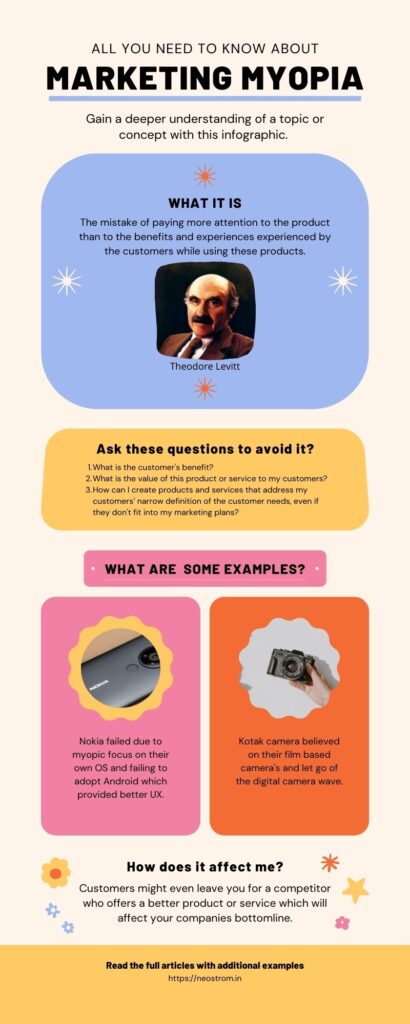What is marketing myopia?
The mistake of paying more attention to the product than to the benefits and experiences experienced by the customers while using these products – Theodore Levitt, Harvard Business Review. It stems from the mistake of thinking that you can create products and services without understanding the customer’s needs. Marketing myopia is a problem with marketers who think they know better than customers what the customer wants. Marketers make decisions based on their own opinions about how to create products or services, rather than the customer’s needs.
What causes marketing myopia?
Often, marketers’ thinking is based on outdated assumptions about what customers want. Theodore Levitt argued that marketing myopia occurs when a company’s primary focus is not the needs of the customer, but on creating products and services that will satisfy those needs. The marketers’ focus is on improving their own business (the product or service) rather than the needs of customers (and how to best serve them). Levitt said: “Marketing myopia is a mistake, and it is a mistake that the typical American company makes at least once every three years.” He also said, “Marketing myopia is an unwillingness to accept that your customers are not just potential buyers of your product. They are human beings with their own needs, fears, hopes, and dreams.”
Examples of Marketing Myopia:
Why did Nokia fail?
In 2007, Nokia was a global market leader in mobile phones. The company had a large share of the world’s mobile phone market and even more important, it held a dominant position in Europe. In 2004, Nokia’s sales grew by 25 percent to 1.5 billion euros ($2 billion). The company had already announced that the next year it would start selling smartphones. However, in 2008 Nokia was in a slump and their sales fell by over 30 percent to 1 billion euros ($1.3 billion). This decline forced them to lay off 4,000 employees and even considered filing for bankruptcy.
In the following years, Nokia was not able to regain its position in the market and failed to generate profits until 2013 when it sold all of its mobile phone business to Microsoft for $7.2 billion. This entire downfall can be attributed to Nokia’s failure of management and its CEO failing to foresee a future past their Symbian operating system in favor of Google’s Android OS. That is why you should always put the needs of your customers before your product.
Why did Blockbuster fail?
Blockbuster was a video rental company that had been around for over 20 years. At the beginning of the 2000s, Blockbuster’s sales were growing by 10 percent per year. In 2005, they even had plans to start selling DVDs online and mobile phones with DVD players as well as new features such as internet access. However, in 2009 Blockbuster announced that they would be closing down all of their stores and ceasing the sale of DVDs. The reason for their fall was that they did not see the shift in consumers’ behavior. The internet had made it easier for customers to find videos online, and since Blockbuster didn’t have an easy way of making money off of that shift, they failed to adapt.
Blockbuster was also too dependent on its product. This was a huge blow to both customers and employees alike since it meant that there would no longer be a place where people could rent movies from anywhere in the world. Blockbuster was also planning to file for bankruptcy but it never happened.
Why did the Kotak camera fail?
Kotak failed to adopt the shift from film to a digital camera system. The shift was made to make it easier for customers to take photos, but Kotak failed to keep up with the changing technology. This is because they only focused on the film cameras and not digital cameras which were making their way into consumers’ hands. These are some of the examples you will hear from business school MBA courses and Philip Kotler books.
Why did Blackberry fail?
Blackberry’s first phone was released in 1999. At the time, cell phones were seen as a luxury item and people would not pay for one until they had to. Blackberry saw this as an opportunity and started producing low-cost handsets that could connect to the internet. However, they failed to keep up with the shifting technology and lost a lot of market share. Their phones lacked many features that were expected in a modern smartphone like a smooth user experience and a good camera. This is what made them fail.
How do I avoid marketing myopia?
The best way to avoid marketing myopia is to understand your customers’ needs and then match these needs with what you offer. This requires an understanding of customer needs that goes beyond what a salesperson can provide, and a willingness to do the research necessary to make sure you’re offering what your customers want. To overcome this condition, you need to ask yourself the following questions:
- What is the customer’s benefit?
- What is the value of this product or service to my customers?
- How can I create products and services that address my customers’ narrow definition of the customer needs, even if they don’t fit into my marketing plans?
Once you’ve answered these questions, then think about what else is needed to create products and services that are useful for your customers. Then ask yourself how you can develop this into a plan. Next, start developing the products or services using methods such as market research, focus groups, and customer interviews.

How do I know if I have marketing myopia?
If you’re concerned that your marketing efforts aren’t delivering the benefits and experiences customers want, then you may have a problem with marketing myopia. If you believe outwards in the approach of selling towards marketing strategy, then you might be experiencing marketing myopia.
What is Self Deceiving Cycle?
Companies believe they are part of the growing industry and get into the myopic view of the self-deceiving cycle.
There are 4 conditions of the self-deceiving cycle:
- The belief is that growth is assured by an expanding and more affluent population.
- The belief is that there is no competitive substitute for the industry’s major product.
- Too much faith in mass production and in the advantages of rapidly declining unit costs as output rises.
- Preoccupation with a product that lends itself to carefully controlled scientific experimentation, improvement, and manufacturing cost reduction.
What is a Step Child Treatment of Your Customers?
When companies believe that their customers are not important to them, they tend to treat their customers as stepchildren. This often leads to bad customer service practices and product defects which can hurt the company’s reputation. They follow a narrow definition of the customer and ignore the evolving needs of their future customers.
How does marketing myopia affect me?
Marketing myopia can hurt your company’s bottom line in the long term. Even successful companies suffer from marketing myopia at some point in time in their lifecycle. Customers may be less satisfied with your products and services than they would have been if you had spent more time listening to what customers wanted. They might even leave you for a competitor who offers a better product or service.
Conclusion
Marketing myopia is a condition that affects the decisions made by marketers and their companies. It’s not easy to overcome this condition, but it can be done with the right mindset and research. Don’t preassume that you are a part of a growth industry and treat your customers as a stepchild. The nearsighted focus of your product will never be the reason for your growth.

Pingback: Difference between Needs, Wants and Demands with Examples | Neostrom